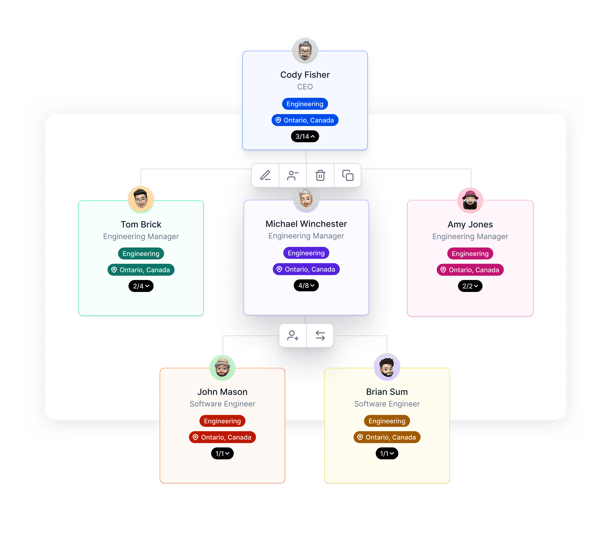An “organigram,” or “organogram,” is another saying for “organizational chart.”
These terms come from the words "organize" and "diagram." “Organigram” accurately describes its function as a visual representation of a company's departments and positions.
This blog will explore the uses, types, and importance of understanding the organogram meaning. We will also provide valuable insight into how they can help navigate the complex world of organizational structures.
 An organigram, or organogram, provides a clear and concise view of an organization's hierarchy and structure. Additionally, it assists in decision-making processes by identifying key positions and responsibilities.
An organigram, or organogram, provides a clear and concise view of an organization's hierarchy and structure. Additionally, it assists in decision-making processes by identifying key positions and responsibilities.
Organizational charts have been used for centuries, dating back to ancient Egyptian and Chinese civilizations. However, the modern organizational chart definition was developed in the late 19th century by Daniel McCallum, a railroad engineer. He created the first organizational chart to illustrate the structure of the New York and Erie Railroad Company.
The term “organigram” originated in the 1950s. It is more common in the UK. Meanwhile, the word “organizational chart” or “org chart” is standard in the US.
Today, organigrams are a practical and valuable tool for organizations, regardless of size and industry.
Organigrams help employees understand their roles and assist with decision-making, resource management, and workforce planning. These diagrams depict the various levels of authority within an organization, enabling individuals to ascertain who holds responsibility for specific tasks.
In particular, an organigram is extremely useful for 3 reasons.
Organigrams are used for succession planning; visually represent the company's structure, including the hierarchy of positions and the relationships between them.
Executive leaders can identify potential successors for critical positions when using an organogram. As a result, they can develop a plan for their development and training. This chart ensures the company has a pipeline of qualified candidates ready to fill essential roles.
Organigrams also allow companies to assess their talent pool, identify skill gaps, and develop strategies to address them.
An organogram makes it easier for new employees to understand the company's overall objectives and how their role fits into the larger picture.
Such knowledge helps new hires navigate their new work environment and better understand their position within the company.
Moreover, organizational charts provide insight into the company's communication channels. These diagrams allow new hires to understand who to contact for inquiries or issues.
Organigrams help identify growth areas within a company and create new job opportunities.
A well-designed organizational chart can help leaders assess the skills and experience required for each new role. It also ensures they hire the right people for the job.
Moreover, an organogram helps the company function more efficiently. It creates new job opportunities that are essential to the company's success.
These are the most common types of organigrams that companies use to illustrate their structure.
Emphasizes departments and functions. This organogram type groups specialties such as marketing, finance, sales, and product development.
Illustrates an organization's structure based on divisions or business units - each with its own set of functions.
Indicates dual reporting relationships. This type of org chart shows how employees report to functional and project managers.
A more decentralized and team-based structure. It underlines the importance of collaboration and teamwork within the organization.
Organigrams are valuable to any company as they:
-
Contribute to organizational efficiency and transparency.
-
Provide a clear and concise overview of the company's structure.
-
Help employees and external stakeholders to understand how the company functions.
-
Aid in employee orientation and onboarding.
-
Ensure that new employees clearly understand their role within the organization.
-
Promote effective management, communication, and collaboration.
-
Help managers to delegate tasks and identify areas that require attention.
-
Improve communication throughout the organization.
Dell Technologies is a great example of a company that benefits from having a clear and well-structured organigram.
Dell has a functional organizational structure with a level of decentralization. This framework enables functional departments to contribute ideas to the organization's success and make some decisions independently.
As a result, Dell was able to communicate and collaborate better between departments. This particular framework led to faster decision-making and increased productivity. In addition, the framework helped maintain a culture of innovation and continuous improvement.
Organigrams, or organizational charts, visually represent a company's departments and positions. They assist in decision-making processes, resource management, and workforce planning.
Organigrams are powerful for succession planning, new hire onboarding, and new job creation.
These charts contribute to organizational efficiency and transparency. They also aid in employee orientation and onboarding. Furthermore, organograms help promote effective management, communication, and collaboration.
About Agentnoon:
Agentnoon is a workforce planning and organizational design software for responsible growth. We help you save time making organigram and visualize all your people data in one place.
Contact us and learn how to create a well-structured organogram for your company.